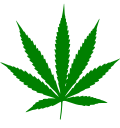Panama red
Panama red, known as Panamanian red,[1] or P.R.[2] is a pure cultivar of Cannabis sativa, popular among cannabis users of the 1960s and 1970s, and renowned for its potency.[3][4][5] The typically high THC levels associated with the variety are thought to be dependent on the particular cultivar, rather than the Panamanian climate.[6][7] It induces a mellow cerebral high, slight body relaxation, characterized by euphoria and increase in energy, boosts creativity. It can cause anxiety and paranoia in some users.[8]
| Part of a series on |
| Cannabis |
|---|
 |
|
|
|
|
Regional
|
|
Variants |
|
In a limited test, an Auburn University researcher reported that "seed of a sample of Panama Red, grown in the very different climates of the Canal Zone, campus and northern New Hampshire, yielded marijuana with similar THC content."[7]
Its name comes from its cultivation in the country of Panama, and its claylike red color.[9] Production was common in Panama's sparsely populated Pearl Islands.[10]
Cannabis cultivation died off in Panama with the rise of cocaine trafficking.
On May 22nd 2020 the season 2 of the animated Netflix's series Trailer Park Boys:The Animated Series was released. In the 6th episode "The First Time We Smoked Weed" Panama Red is frequently mentioned.
The cultivar is mentioned in the 2000 film Meet the Parents.[11] "Panama Red" is the name of a song from the album The Yellow Balloon[12] released in 1967 by the sunshine pop band The Yellow Balloon. It is also referenced in the 1979 film Apocalypse Now.
References
- Dalzell, Tom, and Terry Victor. (2005). The New Partridge Dictionary of Slang and Unconventional English, Volume II: J–Z. Taylor & Francis, p. 1439. Retrieved on 2007-10-02.
- Campbell, Reginald L., R. Everett Langford. (1995). Substance Abuse in the Workplace. CRC Press, p. 185. Retrieved on 2007-10-02.
- Keays, Jim. (1999). His Master's Voice, Allen & Unwin, p. 164. Retrieved on 2007-10-02.
- House Select Committee on Narcotics Abuse and Control. (1989). Legalization of Illicit Drugs: Impact and Feasibility, part I; Hearings before the Select Committee on Narcotics Abuse and Control, House of Representatives. U.S. Government Printing Office: Washington, D.C., p. 398. Y 4.N16:100-2-10, GPO shipping list no.: 89-266-P (pts. I–II). Retrieved on 2007-10-02.
- Geller, Allen, Maxwell Boas. (1969). The Drug Beat. Cowles Book Co., p. xx. Retrieved on 2007-10-02.
- U.S. Department of Health Education and Welfare (1971). Marihuana and Health: A Report to Congress from the Secretary, U.S. Department of Health Education and Welfare. U.S. Government Printing Office: Washington, D.C., p. 14. Retrieved on 2007-10-02.
- Doorenbos, Norman J. (April 2004.) "Botanical Note". Economic Botany, vol. 58, no. 2, doi:10.1663/0013-0001(2004)058[0172:BN]2.0.CO;2.
- "Panama Red strain information". CannaSOS. Retrieved 2016-05-30.
- Girdano, Daniel A., Dorothy Dusek. (1980). Drugs: A Factual Account. Addison-Wesley Longman, Limited, ISBN 0-201-02962-6, p. 75. Retrieved on 2007-10-02.
- Pardey, Lin and Larry Pardey. (1992). Cruising in Seraffyn. Sheridan House, Inc., p. 82. Retrieved on 2007-10-02.
- http://www.imdb.com/title/tt0212338/quotes
- The Yellow Balloon (band)
- "SongFacts - Panama Red". Retrieved November 26, 2006.